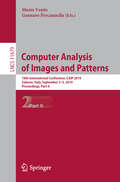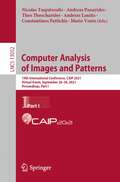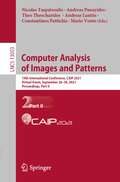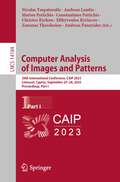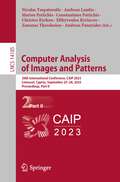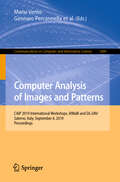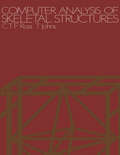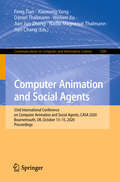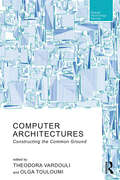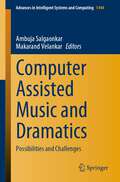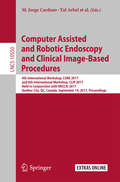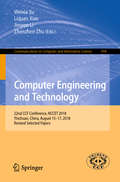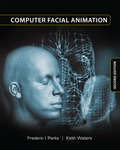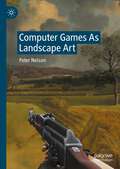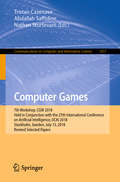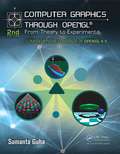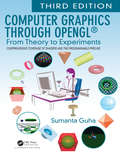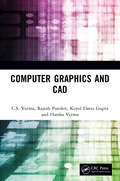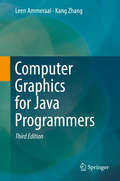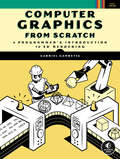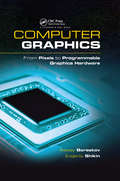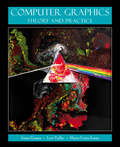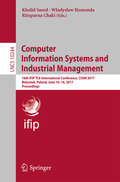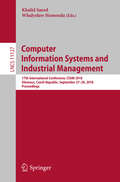- Table View
- List View
Computer Analysis of Images and Patterns: 18th International Conference, CAIP 2019, Salerno, Italy, September 3–5, 2019, Proceedings, Part II (Lecture Notes in Computer Science #11679)
by Mario Vento Gennaro PercannellaThe two volume set LNCS 11678 and 11679 constitutes the refereed proceedings of the 18th International Conference on Computer Analysis of Images and Patterns, CAIP 2019, held in Salerno, Italy, in September 2019. The 106 papers presented were carefully reviewed and selected from 176 submissions The papers are organized in the following topical sections: Intelligent Systems; Real-time and GPU Processing; Image Segmentation; Image and Texture Analysis; Machine Learning for Image and Pattern Analysis; Data Sets and Benchmarks; Structural and Computational Pattern Recognition; Posters.
Computer Analysis of Images and Patterns: 19th International Conference, CAIP 2021, Virtual Event, September 28–30, 2021, Proceedings, Part I (Lecture Notes in Computer Science #13052)
by Mario Vento Nicolas Tsapatsoulis Andreas Panayides Theo Theocharides Andreas Lanitis Constantinos PattichisThe two volume set LNCS 13052 and 13053 constitutes the refereed proceedings of the 19th International Conference on Computer Analysis of Images and Patterns, CAIP 2021, held virtually, in September 2021. The 87 papers presented were carefully reviewed and selected from 129 submissions. The papers are organized in the following topical sections across the 2 volumes: 3D vision, biomedical image and pattern analysis; machine learning; feature extractions; object recognition; face and gesture, guess the age contest, biometrics, cryptography and security; and segmentation and image restoration.
Computer Analysis of Images and Patterns: 19th International Conference, CAIP 2021, Virtual Event, September 28–30, 2021, Proceedings, Part II (Lecture Notes in Computer Science #13053)
by Mario Vento Nicolas Tsapatsoulis Andreas Panayides Theo Theocharides Andreas Lanitis Constantinos PattichisThe two volume set LNCS 13052 and 13053 constitutes the refereed proceedings of the 19th International Conference on Computer Analysis of Images and Patterns, CAIP 2021, held virtually, in September 2021. The 87 papers presented were carefully reviewed and selected from 129 submissions. The papers are organized in the following topical sections across the 2 volumes: 3D vision, biomedical image and pattern analysis; machine learning; feature extractions; object recognition; face and gesture, guess the age contest, biometrics, cryptography and security; and segmentation and image restoration.
Computer Analysis of Images and Patterns: 20th International Conference, CAIP 2023, Limassol, Cyprus, September 25–28, 2023, Proceedings, Part I (Lecture Notes in Computer Science #14184)
by Efthyvoulos Kyriacou Nicolas Tsapatsoulis Andreas Panayides Andreas Lanitis Constantinos Pattichis Marios Pattichis Christos Kyrkou Zenonas TheodosiouThis volume LNCS 14184 and 14185 constitutes the refereed proceedings of the 20th International Conference, CAIP 2023, in Limassol, Cyprus, in September 2023. The 54 full papers presented were carefully reviewed and selected from 67 submissions. They were organized in the following section as follows:Part I-:PAR Contest 2023; Deep Learning; Machine Learning for Image and Pattern Analysis; and Object Recognition and Segmentation.Part II : Biometrics- Human Pose Estimation- Action Recognition; Biomedical Image and Pattern Analysis; and General Vision- AI Applications.
Computer Analysis of Images and Patterns: 20th International Conference, CAIP 2023, Limassol, Cyprus, September 25–28, 2023, Proceedings, Part II (Lecture Notes in Computer Science #14185)
by Efthyvoulos Kyriacou Nicolas Tsapatsoulis Andreas Panayides Andreas Lanitis Constantinos Pattichis Marios Pattichis Christos Kyrkou Zenonas TheodosiouThis volume LNCS 14184 and 14185 constitutes the refereed proceedings of the 20th International Conference, CAIP 2023, in Limassol, Cyprus, in September 2023. The 54 full papers presented were carefully reviewed and selected from 67 submissions. They were organized in the following section as follows:Part I: PAR Contest 2023; Deep Learning; Machine Learning for Image and Pattern Analysis; and Object Recognition and Segmentation.Part II : Biometrics- Human Pose Estimation- Action Recognition; Biomedical Image and Pattern Analysis; and General Vision- AI Applications.
Computer Analysis of Images and Patterns: CAIP 2019 International Workshops, ViMaBi and DL-UAV, Salerno, Italy, September 6, 2019, Proceedings (Communications in Computer and Information Science #1089)
by Mario Vento Gennaro Percannella Sara Colantonio Daniela Giorgi Bogdan J. Matuszewski Hamideh Kerdegari Manzoor RazaakThis book constitutes the refereed proceedings of two workshops held at the 18th International Conference on Computer Analysis of Images and Patterns, CAIP 2019, held in Salerno, Italy, in September 2019: First Workshop on Deep-learning based Computer Vision for UAV, DL-UAV 2019, and the First Workshop on Visual Computing and Machine Learning for Biomedical Applications, ViMaBi 2019. The 12 papers presented in this volume were carefully reviewed and selected from 16 submissions and focus on all aspects of visual computing and machine learning for biomedical applications, and deep-learning based computer vision for UAV.
Computer Analysis of Skeletal Structures
by T. Johns C T RossFirst published in 1981. Computers are now increasingly used by structural engineers to speed up the lengthy calculations involved in the analysis of structures. This book by an author who has already published a series of similar manuals on ALGOL programs, presents computer methods for the analysis of skeletal structures. The main feature of the book is that it contains five full programs in FORTRAN, ready for use. An introductory text and a range of worked examples show how the programs can be used in practise. In addition to its value in design offices this book will also find a place in college and university departments of civil engineering and computer science as a means to introducing studnets to computer techniques.
Computer Animation (Kaleidoscope)
by Darcy LockmanExplains how computer animation is used to make entire films, indicates how it differs from traditional animation, and includes information on the development of that technology.
Computer Animation and Social Agents: 33rd International Conference on Computer Animation and Social Agents, CASA 2020, Bournemouth, UK, October 13-15, 2020, Proceedings (Communications in Computer and Information Science #1300)
by Daniel Thalmann Feng Tian Nadia Magnenat Thalmann Jian Chang Jian Jun Zhang Xiaosong Yang Weiwei XuThis book constitutes the revised selected papers of the 33rd International Conference on Computer Animation and Social Agents, CASA 2020, held in Bournemouth, UK*, in October 2020.The 1 full paper and 13 short papers presented were carefully reviewed and selected from a total of 86 submissions. The papers are organized in topical sections of modelling, animation and simulation; virtual reality; image processing and computer vision.*The conference was held virtually due to the COVID-19 pandemic.
Computer Architectures: Constructing the Common Ground (Routledge Research in Design, Technology and Society)
by Theodora Vardouli Olga TouloumiComputer Architectures is a collection of multidisciplinary historical works unearthing sites, concepts, and concerns that catalyzed the cross-contamination of computers and architecture in the mid-20th century. Weaving together intellectual, social, cultural, and material histories, this book paints the landscape that brought computing into the imagination, production, and management of the built environment, whilst foregrounding the impact of architecture in shaping technological development. The book is organized into sections corresponding to the classic von Neumann diagram for computer architecture: program (control unit), storage (memory), input/output and computation (arithmetic/logic unit), each acting as a quasi-material category for parsing debates among architects, engineers, mathematicians, and technologists. Collectively, authors bring forth the striking homologies between a computer program and an architectural program, a wall and an interface, computer memory and storage architectures, structures of mathematics and structures of things. The collection initiates new histories of knowledge and technology production that turn an eye toward disciplinary fusions and their institutional and intellectual drives. Constructing the common ground between design and computing, this collection addresses audiences working at the nexus of design, technology, and society, including historians and practitioners of design and architecture, science and technology scholars, and media studies scholars.
Computer Assisted Music and Dramatics: Possibilities and Challenges (Advances in Intelligent Systems and Computing #1444)
by Ambuja Salgaonkar Makarand VelankarThis book is intended for researchers interested in using computational methods and tools to engage with music, dance and theatre. The chapters have evolved out of presentations and deliberations at an international workshop entitled Computer Assisted Music and Dramatics: Possibilities and Challenges organized by University of Mumbai in honour of Professor Hari Sahasrabuddhe, a renowned educator and a pioneering computational musicologist (CM) of Indian classical music. The workshop included contributions from CM as well as musicians with a special focus on South Asian arts. The case studies and reflective essays here are based on analyses of genres, practices and theoretical constructs modelled computationally. They offer a balanced and complementary perspective to help innovation in the synthesis of music by extracting information from recorded performances. This material would be of interest to scholars of the sciences and humanities and facilitate exchanges and generation of ideas.
Computer Assisted and Robotic Endoscopy and Clinical Image-Based Procedures
by Cristina Oyarzun Laura Raj Shekhar Stefan Wesarg Miguel Ángel González Ballester Klaus Drechsler Marius Erdt Marius George Linguraru Xiongbiao Luo Tobias Reichl Kensaku Mori M. Jorge Cardoso Terry Peters Tal Arbel Andreas Uhl Jonathan McLeodThis book constitutes the refereed joint proceedings of the 4th International Workshop on Computer Assisted and Robotic Endoscopy, CARE 2017, and the 6th International Workshop on Clinical Image-Based Procedures: Translational Research in Medical Imaging, CLIP 2017, held in conjunction with the 20th International Conference on Medical Imaging and Computer-Assisted Intervention, MICCAI 2017, in Québec City, QC, Canada, in September 2017. The 7 full papers presented at CARE 2017 and the 10 full papers presented at CLIP 2017 were carefully reviewed and selected. The papers deal with interventional and diagnostic endoscopy integrating the latest advances in computer vision, robotics, medical imaging and information processing and the development and evaluation of new translational image-based techniques in the modern hospital.
Computer Engineering and Technology: 22nd CCF Conference, NCCET 2018, Yinchuan, China, August 15–17, 2018, Revised Selected Papers (Communications in Computer and Information Science #994)
by Weixia Xu Liquan Xiao Jinwen Li Zhenzhen ZhuThis book constitutes the refereed proceedings of the 22nd CCF Conference on Computer Engineering and Technology, NCCET 2018, held in Yinchuan, China, in August 2018.The 17 full papers presented were carefully reviewed and selected from 120 submissions. They address topics such as processor architecture; application specific processors; computer application and software optimization; technology on the horizon.
Computer Facial Animation
by Keith Waters Frederic I. ParkeThis comprehensive work provides the fundamentals of computer facial animation and brings into sharper focus techniques that are becoming mainstream in the industry. Over the past decade, since the publication of the first edition, there have been significant developments by academic research groups and in the film and games industries leading to t
Computer Games As Landscape Art
by Peter NelsonThis book proposes that computer games are the paradigmatic form of contemporary landscape and offers a synthesis of art history, geography, game studies and play. Like paint on canvas, the game engine is taken as the underlying medium, and using the Valve Source Engine as the primary case study, it analyses landscapes according to the technical, economic and cultural features this medium affords. It presents the single-player first-person shooter (Half-Life 2) as a Promethean safari, examines how the economics of gambling and product placement shaped the eSports landscapes of Counter-Strike and reveals how sandboxes such as Garry’s Mod visualise the radical landscape of Web 2.0. This book explores how our relationship to the environment is changing, how we express this through computer games and how we can move beyond examining artistic influences on games to examining how historical connections flow through games and the history of landscape images.
Computer Games: 7th Workshop, CGW 2018, Held in Conjunction with the 27th International Conference on Artificial Intelligence, IJCAI 2018, Stockholm, Sweden, July 13, 2018, Revised Selected Papers (Communications in Computer and Information Science #1017)
by Tristan Cazenave Abdallah Saffidine Nathan SturtevantThis book constitutes revised selected papers from the 7th Workshop on Computer Games, CGW 2018, held in conjunction with the 27th International Conference on Artificial Intelligence, IJCAI 2018 in Stockholm, Sweden, in July 2018.The 8 full papers presented in this volume were carefully reviewed and selected from 15 submissions. They cover a wide range of topics related to video games; general game playing.- machine learning and Monte Carlo tree search.
Computer Graphics Through OpenGL: From Theory to Experiments
by Sumanta GuhaFrom geometric primitives to animation to 3D modeling to lighting, shading, and texturing, Computer Graphics Through OpenGL: From Theory to Experiments, Second Edition presents a comprehensive introduction to computer graphics that uses an active learning style to teach key concepts. Equally emphasizing theory and practice, the book provides an und
Computer Graphics Through OpenGL®: From Theory to Experiments
by Sumanta GuhaCOMPREHENSIVE COVERAGE OF SHADERS AND THE PROGRAMMABLE PIPELINE <P><P> From geometric primitives to animation to 3D modeling to lighting, shading and texturing, Computer Graphics Through OpenGL®: From Theory to Experiments is a comprehensive introduction to computer graphics which uses an active learning style to teach key concepts. Equally emphasizing theory and practice, the book provides an understanding not only of the principles of 3D computer graphics, but also the use of the OpenGL® Application Programming Interface (API) to code 3D scenes and animation, including games and movies. The undergraduate core of the book takes the student from zero knowledge of computer graphics to a mastery of the fundamental concepts with the ability to code applications using fourth-generation OpenGL®. The remaining chapters explore more advanced topics, including the structure of curves and surfaces, applications of projective spaces and transformations and the implementation of graphics pipelines. This book can be used for introductory undergraduate computer graphics courses over one to two semesters. The careful exposition style attempting to explain each concept in the simplest terms possible should appeal to the self-study student as well. <P><P> Features <br>• Covers the foundations of 3D computer graphics, including animation, visual techniques and 3D modeling• Comprehensive coverage of OpenGL® 4.x, including the GLSL and vertex, fragment, tessellation and geometry shaders• Includes 180 programs with 270 experiments based on them• Contains 750 exercises, 110 worked examples, and 700 four-color illustrations• Requires no previous knowledge of computer graphics• Balances theory with programming practice using a hands-on interactive approach to explain the underlying concepts
Computer Graphics and CAD
by C.S. Verma Rajesh Purohit Koyel Datta Gupta Harsha VermaThis book discusses the fundamental concepts shaping modern design and visualization definition through Computer Graphics and the intricacies of CAD modelling practices.From 3D object representation to surface modelling and solid techniques, subsequent chapters offer a comprehensive exploration of advanced topics essential for geometric modelling. With a focus on industry applications and practical examples, readers acquire the skills needed to navigate the complexities of animation systems and finite element analysis, ensuring a holistic understanding of CAD and Computer Graphics. Whether you're a novice or seasoned professional, this guide provides a rich blend of theory and practice, accompanied by a wealth of solved and unsolved problems for hands-on learning.Print edition not for sale in South Asia (India, Sri Lanka, Nepal, Bangladesh, Pakistan or Bhutan)
Computer Graphics for Java Programmers
by Leen Ammeraal Kang ZhangThis third edition covers fundamental concepts in creating and manipulating 2D and 3D graphical objects, including topics from classic graphics algorithms to color and shading models. It maintains the style of the two previous editions, teaching each graphics topic in a sequence of concepts, mathematics, algorithms, optimization techniques, and Java coding. Completely revised and updated according to years of classroom teaching, the third edition of this highly popular textbook contains a large number of ready-to-run Java programs and an algorithm animation and demonstration open-source software also in Java. It includes exercises and examples making it ideal for classroom use or self-study, and provides a perfect foundation for programming computer graphics using Java. Undergraduate and graduate students majoring specifically in computer science, computer engineering, electronic engineering, information systems, and related disciplines will use this textbook for their courses. Professionals and industrial practitioners who wish to learn and explore basic computer graphics techniques will also find this book a valuable resource.
Computer Graphics from Scratch: A Programmer's Introduction to 3D Rendering
by Gabriel GambettaComputer Graphics from Scratch demystifies the algorithms used in modern graphics software and guides beginners through building photorealistic 3D renders.Computer graphics programming books are often math-heavy and intimidating for newcomers. Not this one. Computer Graphics from Scratch takes a simpler approach by keeping the math to a minimum and focusing on only one aspect of computer graphics, 3D rendering. You&’ll build two complete, fully functional renderers: a raytracer, which simulates rays of light as they bounce off objects, and a rasterizer, which converts 3D models into 2D pixels. As you progress you&’ll learn how to create realistic reflections and shadows, and how to render a scene from any point of view. Pseudocode examples throughout make it easy to write your renderers in any language, and links to live JavaScript demos of each algorithm invite you to explore further on your own.Learn how to:Use perspective projection to draw 3D objects on a 2D planeSimulate the way rays of light interact with surfacesAdd mirror-like reflections and cast shadows to objectsRender a scene from any camera position using clipping planesUse flat, Gouraud, and Phong shading to mimic real surface lightingPaint texture details onto basic shapes to create realistic-looking objects Whether you&’re an aspiring graphics engineer or a novice programmer curious about how graphics algorithms work, Gabriel Gambetta&’s simple, clear explanations will quickly put computer graphics concepts and rendering techniques within your reach. All you need is basic coding knowledge and high school math. Computer Graphics from Scratch will cover the rest.
Computer Graphics: From Pixels to Programmable Graphics Hardware (Chapman And Hall/crc Computer Graphics, Geometric Modeling, And Animation Ser. #3)
by Alexey Boreskov Evgeniy ShikinComplete Coverage of the Current Practice of Computer GraphicsComputer Graphics: From Pixels to Programmable Graphics Hardware explores all major areas of modern computer graphics, starting from basic mathematics and algorithms and concluding with OpenGL and real-time graphics. It gives students a firm foundation in today's high-performance graphic
Computer Graphics: Theory and Practice
by Jonas Gomes Luiz Velho Mario Costa SousaComputer Graphics: Theory and Practice provides a complete and integrated introduction to this area. The book only requires basic knowledge of calculus and linear algebra, making it an accessible introductory text for students. It focuses on conceptual aspects of computer graphics, covering fundamental mathematical theories and models and the inher
Computer Information Systems and Industrial Management: 16th IFIP TC8 International Conference, CISIM 2017, Bialystok, Poland, June 16-18, 2017, Proceedings (Lecture Notes in Computer Science #10244)
by Khalid Saeed Rituparna Chaki Władysław HomendaThis book constitutes the proceedings of the 15th IFIP TC8 International Conference on Computer Information Systems and Industrial Management, CISIM 2016, held in Vilnius, Lithuania, in September 2016. The 63 regular papers presented together with 1 inivted paper and 5 keynotes in this volume were carefully reviewed and selected from about 89 submissions. The main topics covered are rough set methods for big data analytics; images, visualization, classification; optimization, tuning; scheduling in manufacturing and other applications; algorithms; decisions; intelligent distributed systems; and biometrics, identification, security.
Computer Information Systems and Industrial Management: 17th International Conference, CISIM 2018, Olomouc, Czech Republic, September 27-29, 2018, Proceedings (Lecture Notes in Computer Science #11127)
by Khalid Saeed Władysław HomendaThis book constitutes the proceedings of the 17th International Conference on Computer Information Systems and Industrial Management Applications, CISIM 2018, held in Olomouc, Czech Republic, in September 2018. The 42 full papers presented together with 4 keynotes were carefully reviewed and selected from 69 submissions. The main topics covered by the chapters in this book are biometrics, security systems, multimedia, classification and clustering, and industrial management. Besides these, the reader will find interesting papers on computer information systems as applied to wireless networks, computer graphics, and intelligent systems. The papers are organized in the following topical sections: biometrics and pattern recognition applications; computer information systems; industrial management and other applications; machine learning and high performance computing; modelling and optimization; and various aspects of computer security.
